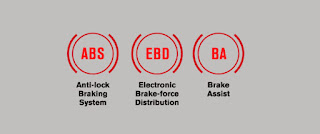Car tyre maintenance and rotation
When it comes to tyres, the myriad myths surrounding it
are flabbergasting. Be it the tyre rotation, tyre maintenance, tyre pressure,
anything and everything regarding tyres are spoken off in abundance, every
mortal has his own set of opinions.
To unravel some of those myths and to unearth the points
that really count, I put forth here the critical aspects of tyre maintenance.
Car Tyre Rotation:
The most neglected and often overlooked aspect is
rotation of the tyres on a regular basis. This is the most critical aspect to
get the maximum life out of the rubber. Any decent tyre can easily run for
50,000 to 60,000 km if maintained properly. The key is to have an even wear and
tear on all the 5 tyres. YES! 5. Most people forget that the spare tyre
actually is very important in this process, if you want to have the maximum from
your tyres.
A simple diagrammatic explanation on how the tyres should
be rotated is explained in the image below.
This rotation should be carried about after every 5,000 km
run. This rotation works well for front wheel drive, rear wheel drive and 4 wheel drive as well. It ensures that all the 5 tyres are run in all possible directions with
all possible weight combinations hence an even wear and tear for all tyres thus
maximizing their life. In between this 5000 km if you face a flat tyre situation
and you have to use the spare wheel for a few kilometeres then as soon as you
get the wheel fixed, put it back in its original position and the spare wheel
should go back immediately. This will ensure that there is no hindrance in the
rotation policy. Sometimes the servicing centres replace the tyres while doing
certain mechanical job, to ensure they placed the tyres in the correct position
is almost impossible. Hence it is advisable if we just number the tyres for our
sake of convenience. Use a simple paint to number the tyres somewhere inside
the rim where it isn’t openly visible.
Car tyre pressure:
Second point to ponder is the recommended pressure. Always
study the car manual and ensure the recommended pressures are maintained. Get the
pressure checked regularly ideally every fortnight. The wear and tear of the
tyre is significantly dependent on the tyre pressure. Anything higher than
recommended will result in tyres getting uneven wear from the centre. Anything less
than recommended will result in the trim of the wheel to wear fast. To ensure
that the trim and the centre of the wheel have equal wear, the pressure should
be ideal.
Myth about tyres:
Another myth that surrounds the driving community is that
while going on highway tyre pressure should be reduced. The logic they give is
that the tyre gets heated and hence the air expands and might result in tyre
burst. Well, scientifically it looks okay but factually it’s wrong. The companies
give the recommended tyre pressure under COLD conditions. One should always get
his tyre pressure checked early in the morning or late evening after minimal
driving. Never one should check it in a hot day after a long drive. So when you
go on a highway it’s always recommended to have a bit higher pressure than recommended
rather than lower. If the pressure is lower than recommended the wear and tear
will be far more as both the trim and the centre will be rubbing against the
road, increasing the chances of burst. In higher than recommended pressure only
the centre of the wheel will touch the road avoiding the trim hence less danger
of tyre burst. Ideally during highways the tyres should have 2-3 psi more than
recommended in all tyres.
Quality of Rubber:
Besides, another insight is important to know more about
the quality of the rubber of the tyres. If the rubber is hard, the life of the
tyre will increase but you will feel the road more. The gravels on the road will
be more noticeable although the life will be more for your tyre.
However if the rubber is soft, the feel of the gravels on
the road will be less. Not to mention the life will also decrease. So it is
kind of a trade-off. I personally prefer hard rubber with more life than soft
rubber with more comfort. Obviously it doesn’t mean that hard rubber is not comfortable.
It’s just a fraction difference of comfort and durability. To quote certain
examples, MRF usually is hard rubber and Bridgestone / Michellin is soft
rubber.
The brand could be anything; it’s how you treat your
tyres that define their life.
Happy Driving!








